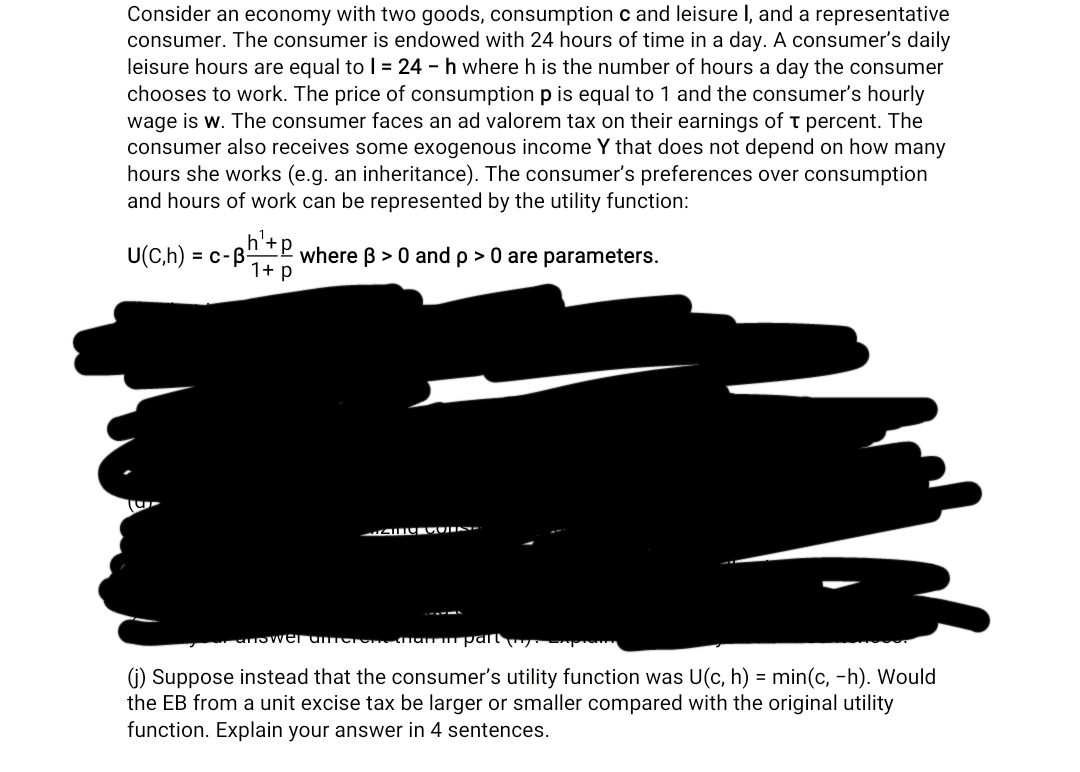Consider an economy with two goods, consumption c and leisure I, and a representative consumer. The consumer is endowed with 24 hours of time in a day. A consumer's daily leisure hours are equal to 1 = 24-h where h is the number of hours a day the consumer chooses to work. The price of consumption p is equal to 1 and the consumer's hourly wage is w. The consumer faces an ad valorem tax on their earnings of T percent. The consumer also receives some exogenous income Y that does not depend on how many hours she works (e.g. an inheritance). The consumer's preferences over consumption and hours of work can be represented by the utility function: h'+p U(C,h) = c-B- 1+ p where ß> 0 and p > 0 are parameters. TENTO CUITS ar answer aneren hanm pally. pa (j) Suppose instead that the consumer's utility function was U(c, h) = min(c, -h). Would the EB from a unit excise tax be larger or smaller compared with the original utility function. Explain your answer in 4 sentences.
Consider an economy with two goods, consumption c and leisure I, and a representative consumer. The consumer is endowed with 24 hours of time in a day. A consumer's daily leisure hours are equal to 1 = 24-h where h is the number of hours a day the consumer chooses to work. The price of consumption p is equal to 1 and the consumer's hourly wage is w. The consumer faces an ad valorem tax on their earnings of T percent. The consumer also receives some exogenous income Y that does not depend on how many hours she works (e.g. an inheritance). The consumer's preferences over consumption and hours of work can be represented by the utility function: h'+p U(C,h) = c-B- 1+ p where ß> 0 and p > 0 are parameters. TENTO CUITS ar answer aneren hanm pally. pa (j) Suppose instead that the consumer's utility function was U(c, h) = min(c, -h). Would the EB from a unit excise tax be larger or smaller compared with the original utility function. Explain your answer in 4 sentences.
Chapter17: Capital And Time
Section: Chapter Questions
Problem 17.1P
Related questions
Question

Transcribed Image Text:Consider an economy with two goods, consumption c and leisure I, and a representative
consumer. The consumer is endowed with 24 hours of time in a day. A consumer's daily
leisure hours are equal to 1 = 24 - h where h is the number of hours a day the consumer
chooses to work. The price of consumption p is equal to 1 and the consumer's hourly
wage is w. The consumer faces an ad valorem tax on their earnings of T percent. The
consumer also receives some exogenous income Y that does not depend on how many
hours she works (e.g. an inheritance). The consumer's preferences over consumption
and hours of work can be represented by the utility function:
h'+p
U(C,h) = c-B-
1+ p
where ß> 0 and p > 0 are parameters.
TENTO COITS
ar answer aneren ananm pally. p
(j) Suppose instead that the consumer's utility function was U(c, h) = min(c, -h). Would
the EB from a unit excise tax be larger or smaller compared with the original utility
function. Explain your answer in 4 sentences.
Expert Solution
This question has been solved!
Explore an expertly crafted, step-by-step solution for a thorough understanding of key concepts.
Step by step
Solved in 2 steps

Knowledge Booster
Learn more about
Need a deep-dive on the concept behind this application? Look no further. Learn more about this topic, economics and related others by exploring similar questions and additional content below.Recommended textbooks for you

